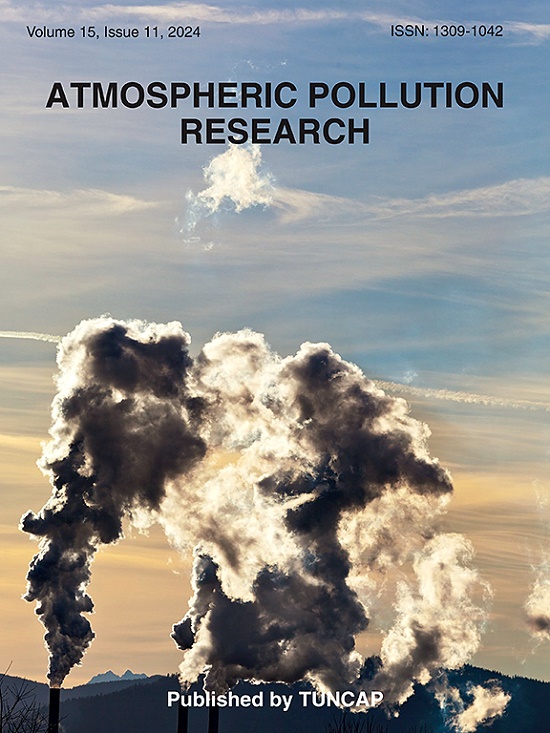Identification of PM10 episodes in Tehran, Iran: Regional versus local causes
IF 3.5
3区 环境科学与生态学
Q2 ENVIRONMENTAL SCIENCES
引用次数: 0
Abstract
Middle Eastern sand and dust storms (SDSs) can deteriorate air quality and human health of millions of inhabitants in downwind areas such as Tehran, Iran. Limited information is available about severity, frequency, magnitude, and duration of PM10 episodes in Tehran. To identify PM10 episodes between 2015 and 2021, the Seasonal-Trend decomposition procedure based on Loess (STL) method was applied to measured PM10 concentrations at 15 sites across Tehran. The PM10 episodes were separated into 3 duration categories (PE1, PE2, and PE3). The PM10 concentrations and related meteorological characteristics of the episodes were analyzed to assess the differences. All sites had higher PM10 concentrations compared to AQG levels for daily (24-h) PM10 (45 μg m−3). PM10 episode frequency, magnitude, and duration were 2.60/year, 35.0 percent, and 1 day/episode over the 7-years study period, respectively. The overall frequency of PM10 PE1, PE2, and PE3 events were 205, 54, and 14, respectively. Events dissipated under strong westerly winds. PM10 accumulation occurred periods of weakening of the westerly winds to stagnant conditions. Site-specific bivariate polar plots (BBPs) also supported this finding. The increase of regional dust during high wind speeds on dusty days led to lower PM2.5/PM10 ratios at most sites. Back trajectory analyses of PM10 concentrations showed that the transboundary transport from westerly directions produced the high PM10 concentrations. Understanding the PM10 pollution episode characteristics could permit planning of practical anthropogenic emissions reductions and support the joint air pollution control strategies for regional air pollution.
伊朗德黑兰PM10事件的识别:区域性与地方性原因
中东沙尘暴(SDSs)会使伊朗德黑兰等顺风地区数百万居民的空气质量和人类健康恶化。关于德黑兰PM10发作的严重程度、频率、震级和持续时间的信息有限。为了确定2015年至2021年间的PM10事件,基于黄土(STL)方法的季节趋势分解程序应用于德黑兰15个站点的PM10浓度测量。PM10发作分为PE1、PE2、PE3 3个持续时间类别。分析各时段PM10浓度及相关气象特征,探讨差异。与AQG每日(24小时)PM10水平(45 μg m−3)相比,所有站点的PM10浓度均较高。在7年的研究期间,PM10发作频率、强度和持续时间分别为2.60次/年、35.0%和1天/次。PM10、PE1、PE2和PE3的总频次分别为205次、54次和14次。事件在强烈的西风中消散了。PM10的积累发生在西风减弱至停滞状态的时期。特异位点双变量极坐标图(BBPs)也支持这一发现。多尘日高风速下区域扬尘量增加导致大部分站点PM2.5/PM10比值降低。PM10浓度的反轨迹分析表明,来自西风方向的跨界输送产生了较高的PM10浓度。了解PM10污染事件特征有助于规划实际的人为减排,并为区域空气污染联合控制策略提供支持。
本文章由计算机程序翻译,如有差异,请以英文原文为准。
求助全文
约1分钟内获得全文
求助全文
来源期刊

Atmospheric Pollution Research
ENVIRONMENTAL SCIENCES-
CiteScore
8.30
自引率
6.70%
发文量
256
审稿时长
36 days
期刊介绍:
Atmospheric Pollution Research (APR) is an international journal designed for the publication of articles on air pollution. Papers should present novel experimental results, theory and modeling of air pollution on local, regional, or global scales. Areas covered are research on inorganic, organic, and persistent organic air pollutants, air quality monitoring, air quality management, atmospheric dispersion and transport, air-surface (soil, water, and vegetation) exchange of pollutants, dry and wet deposition, indoor air quality, exposure assessment, health effects, satellite measurements, natural emissions, atmospheric chemistry, greenhouse gases, and effects on climate change.
 求助内容:
求助内容: 应助结果提醒方式:
应助结果提醒方式:


